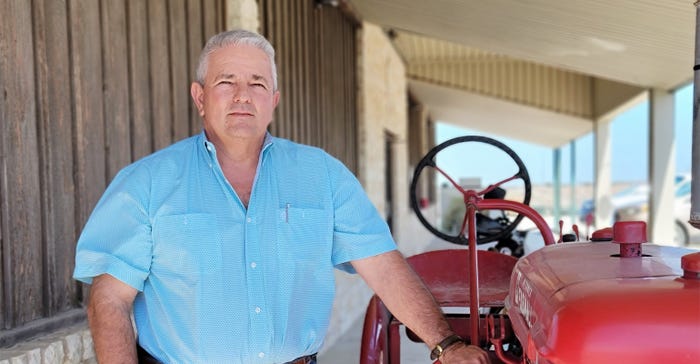
Todd McGraw, Williams Gin & Grain manager, Frost, TexasShelley E. Huguley
Entering Frost, Texas, population 882, a sign at the local park reads, "Welcome to Frost. Where cotton is king and friendliness is queen." While cotton still reigns alongside corn, the landscape of this community, nestled halfway between Dallas and Waco, is changing.
And nowhere is this transformation more evident than on weekends at the local farm and ranch supply store.
"On Saturday mornings, the joke is, how many new people are we going to meet," says Todd McGraw, Williams Gin and Grain manager. "Used to, you knew every face that walked in the door. It's amazing how many people are coming into the area."
According to the most recent United States census data, Navarro County, where Frost and larger towns such as Corsicana are located, has experienced an 8.3% population growth since 2010.
 (Photo by Shelley E. Huguley)
(Photo by Shelley E. Huguley)
"So many people want to get out of the city and own some land," McGraw says. "There's also been a few people from out of state that have moved here."
See, Stutzman credits practices, God, family for high-quality peanuts
McGraw grew up 5 miles from Frost in Blooming Grove and has managed Williams Gin and Grain since 1993. He describes the area as ever-changing. "And it's always been changing," he says, but the speed at which that's happening has escalated.
Initially, Williams Gin and Grain was housed in a small office in downtown Frost with no retail. Eventually, the company expanded west of Frost, building a farm and ranch supply store and a dry blend fertilizer plant, along with its cotton gin and three grain elevators.

A Farmall Super A sits on display at the Williams Gin and Grain Farm and Ranch Supply store. (Photo by Shelley E. Huguley)
The new facility opened in 2006 and business has been "really good," McGraw says. Because much of the area's development has been for ranchette-type places, what customers purchase has also changed.
"The clientele have more animals on smaller tracts of land, so they're coming in to get feed," McGraw says. "They're really good customers. I hate to see land get cut up but for us, it hasn't been all that bad financially because you get 10 customers where you used to have one."
Renewable energy development
Texas leads the United States in the number of farms and ranches, with nearly 250,000 covering 127 million acres. But the development of wind and solar farms in the region has McGraw, who also farms and runs cattle, concerned about the future of production agriculture.
"We've got so many wind turbine companies and solar farm companies coming in now," he says, expressing his greatest concern with solar development. "It's taking land out of production agriculture in pretty big spots. I farm at Barry (10 miles east of Frost) and there was a 2,200-acre solar farm that went in over there. All of it doesn't have panels on it but a big part of it does."
In 2021, Texas was the top-ranked state for solar capacity additions, surpassing California, according to the Solar Energy Industries Association.
The rub? Once solar panels are installed, the land is taken out of production for 25 to 30 years, says McGraw, "which is probably forever. There's talk of several more going in around here."
His preference for the wind farms over solar is two-fold. One, because producers can continue to farm and run cattle on the same property. Two, because they may serve as a deterrent. Once windmills are installed on a farm, it's not likely to be purchased for development, "so it keeps ag in ag longer," he says.
Crops
This season, drought has plagued the region's cotton and corn crops. While a few rain showers have brought some reprieve, the recent triple-digit temperatures threaten yields.
"The last three weeks and for sure the last two weeks, we've had over 100-degree temperatures. The crops have really gone downhill," McGraw says. "Everybody keeps saying we still have some of the better corn around the area. I've been a few places and that's probably right. There's about a 10-mile radius around here that has a pretty good crop -- not a real good crop -- but better than what we're seeing other places."
Corn is Williams Gin & Grain's number one crop. "We sell corn every day here. We only gin cotton about 70 days out of the year." And while the facility can house up to 4 million bushels of corn, current conditions has McGraw concerned producers will only see 60 to 70-bushel yields so it may be hard to fill up the grain bins.
Cotton
This year, Texas is expected to produce 6.80 million acres of upland cotton. Williams Gin is anticipating 17,500 acres with expectations of ginning 25,000 - 30,000 bales. But if it doesn't start raining, McGraw says yields will suffer.
"Some of these fields have bloomed clear to the top, so it's about done. Some fields are later so we have all stages. Some cotton is 6 inches tall and some two-feet tall."
He says the early-planted cotton looks good, "if you're driving down the road, but it's just not as big as we would like, and the bolls could be small."
With harvest on the horizon, McGraw, like many, is always concerned about whether the gin will have enough labor. "It's hard to get help. It is hard for the local farmers also. We do have a younger group of farmers, some fathers, sons, and grandsons. Some of them have high school kids and they bring their buddies to tarp modules, like an after-school tarping crew to come around and help. But it's difficult."
In 2021, area producers made more cotton than anticipated. "It would have been difficult to put two crews together last year, " McGraw says. "This year, if it rains pretty soon and we make a good crop, I've got to have two crews because we could gin up to 30,000 bales and right now that would still be difficult to do."
This year, to reduce the need for labor, the gin purchased an automated bagger -- an investment McGraw was hesitant about making. "I've got guys that can do that job. It's not a technical job, but I might not be able to get those two guys back again this time, so we purchased it."
Seconds after signing the papers, he says he had buyer's remorse. "I just really hadn't been for purchasing it, but we've got to be sure we've got enough people."
Production challenges
Drought, high input and equipment costs and the recent drop in commodity prices have producers stressed. As McGraw reflects on the region's farming, he describes the last couple of years as "pretty good," while he lists 1996, 1998, 2006 and 2011 as very difficult. 2022 is on track to be added to that list.
"The heat and less rain and the prices of commodities have fallen over the last week. Cotton that was $1.33 for December 2022 cotton, not all that long ago, is now 94 cents. And that's not because anybody's grown more cotton since then. It's doesn’t have anything to do with increasing our supply cotton. Corn has come down, probably 50, 60 to 70 cents a bushel and wheat's down $2 a bushel.
"So, we're in worse shape than we were because producers have already spent the high input prices," McGraw says. "We've got some corn and cotton sold and contracted, but you don't ever know what you're going to make, so you can't sell it all. Everything that's unsold looks to be cheaper"
McGraw has a customer who says he likes to play offense. "But sometimes you've got to play a little defense, and I think this is one of those years."
Read more about:
DroughtAbout the Author(s)
You May Also Like






